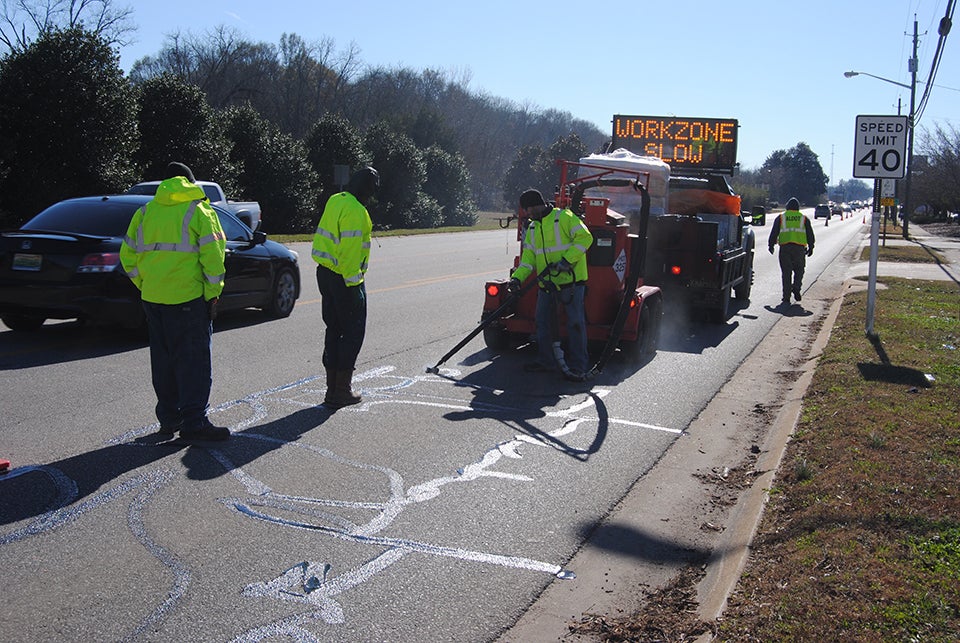Winter Storm Grayson to bring low temperatures this weekend
Published 10:05 am Wednesday, January 3, 2018

- HOT JOB ON A COLD DAY – Spreading hot tar on a highway can be a hot job, especially on a warm summer day. It’s not so bad, though, when it’s done on a chilly afternoon. Shown is an Alabama Department of Transportation (ALDOT) crew on Highway 29 in Lanett Tuesday afternoon. With temperatures in the 30s, there were no complaints about the heat. The hot tar dries quickly and acts to seal cracks on the road surface. (Photo by Wayne Clark)
GREATER VALLEY AREA — Winter Storm Grayson has the eastern half of the United States in an icy grip, and cold weather conditions will likely persist for several more days.
According to The Weather Channel, night time temperatures for the Greater Valley Area should range from a low of 19 that’s forecast for Thursday night, lower 20s for Wednesday and Friday and mid 20s for Saturday. The low temperatures are expected to climb into the upper 40s and low 50s on Sunday and Monday, when rain is in the forecast.
It’s very cold weather but nowhere near record levels. The coldest-ever night in the Valley’s recorded history took place on Jan. 21, 1985, when the mercury dipped down to 8 below. That broke a local record that had stood for 86 years. On Feb. 13, 1899, the temperature dropped to 5 below. Another cold day took place on Dec. 13, 1962, when the temperature dropped to zero on the Fahrenheit scale.
Given the lingering cold weather, we thought it would be a good time to give Chambers County EMA Director Donnie Smith a call to ask him for advice on being prepared for a winter storm.
What’s most important, he told us, is to keep up with the weather and have a plan to deal with it. Having a plan is one of the four P’s when it comes to winter weather, the other three being pipes (make sure they are wrapped), pets and plants (make sure you keep them warm).
A plan is just good, basic common sense. Before the storm strikes, make sure your home, office and vehicles are stocked with the supplies you might need. Make sure your farm animals and pets will have the essentials they will need during a winter storm. Know how to dress for frigid conditions.
Be aware of icy conditions on the road and take precautions such as keeping your tank filled with gas and having items in your car. These include a first aid kit, a cell phone charger, a flashlight, blankets and extra clothes such as mittens, warm clothes and boots.
When caught in a winter storm, there are some life-saving actions you can take to protect yourself and loved ones. Try to stay indoors. Should your heat go out, close off unneeded rooms to avoid wasting heat, stuff towels or rags under doors, close curtains or blinds to keep in some heat, eat and drink – food provides the body with energy for producing its own heat – and wear layers of loose-fitting, lightweight, warm clothing.
Understand what those colors mean when you are watching the Weather Channel. Pink means there’s a winter storm warning and that snow, sleet or ice is expected. Confidence is high that this will be taking place and that it could cause significant impacts.
Blue is for a winter storm watch. Snow, sleet or ice is possible, and it’s wise to take precautions. Purple is for a winter weather advisory. Light amounts of wintry precipitation or patchy, blowing snow are possible. This could cause the roadways to become slick and dangerous for travel.
The danger hasn’t passed when the storm is over and the snow and ice begin to melt. Melting snow has been known to produce floods. Creeks and rivers often overflow their banks from the rush of melting snow. Snow and ice may have brought down power lines and caused gas leaks, both of which can be deadly but not obvious at first glance.
The best advice is to be prepared before, during and after a winter storm.




